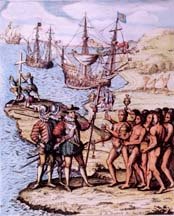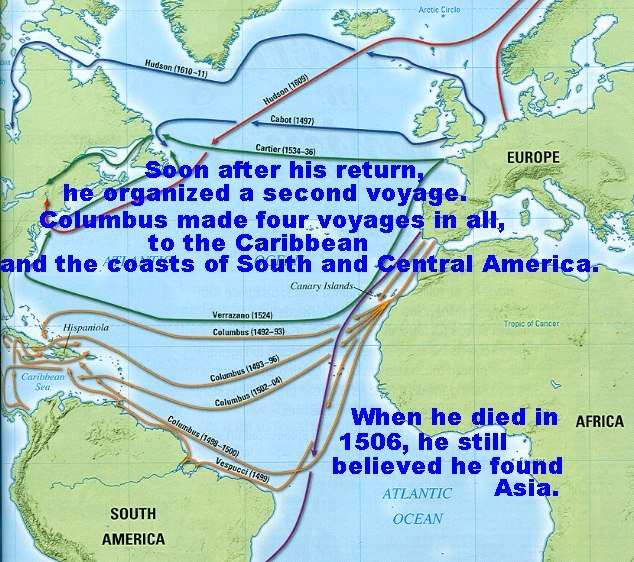Christopher Columbus

Francisco Pizarro

Chapter 1: Colombus and the Indians
For this unit you will be reading Chapter 1 from the Zinn book. Some of the topics that will be covered are: The Arawaks’ Impossible Task, Telling Columbus’s Story and the many different interactions between people and the fighting that resulted. The purpose of this chapter is to expose the misconceptions about Columbus, and introduce the actual facts.
Columbus and Indians

Connecting ZInn to Espada
Espada, Martin. Zapata’s Discipline. Cambridge: South End Press, 1998.
*“In Conquest of Paradise by Kirkpatrick Sale we find Columbus the slaver, who first ordered “seven heads” of indigenous people kidnapped and brought to his ship, the enslaved thousands of others; Columbus the plunder, so obsessed with gold that he referred to the precious metal more than 180 times in the journal for the first voyage; and Columbus the tyrant, who, as governor of Española in 1445 initiated a tribute system whereby “Indians” brought gold dust to the Spanish, or had their hands cut off. During his administration, indigenous people were hanged by Spanish in groups of thirteen, in honor of Christ and the Twelve Apostlez” (Espada 90).
In class assignment, when looking at this information look into the Chapter 1 “Columbus and the Indians” in Young People’s History of the United States Columbus to Mexican American War by Howard Zinn.
*“In Conquest of Paradise by Kirkpatrick Sale we find Columbus the slaver, who first ordered “seven heads” of indigenous people kidnapped and brought to his ship, the enslaved thousands of others; Columbus the plunder, so obsessed with gold that he referred to the precious metal more than 180 times in the journal for the first voyage; and Columbus the tyrant, who, as governor of Española in 1445 initiated a tribute system whereby “Indians” brought gold dust to the Spanish, or had their hands cut off. During his administration, indigenous people were hanged by Spanish in groups of thirteen, in honor of Christ and the Twelve Apostlez” (Espada 90).
In class assignment, when looking at this information look into the Chapter 1 “Columbus and the Indians” in Young People’s History of the United States Columbus to Mexican American War by Howard Zinn.
Columbus' Arrival

Different illustrations of Colombus, his ships, depictions of his journeys..
Columbus Voyage

Making connections between various writers and the myth of Colombus.
Cosby, Alfred W. “Reassessing 1492.”JStor. University of California, Santa Cruz Lib., N1 Nov. 2007 .
*“Scholarly title for the most important event of 1492 is no longer “Columbus-discovered-America,” that event is the “Encounter” (Crosby 662)
*“Castastrophism: the product of multiple beginnings divided and punctuated by abrupt transformations; large scale change within narrow time limits.” (Cosby 663)
Columbian Exchange “Smallpox pandemic that killed thousands” (Cosby 664)
Assignment: 2-page paper on what other historical event has had a “large scale change within a narrow time limit”
Wallerstein, Immanuel. The Modern World-System: Capitalist Agriculture and the Origins of the European World-Economy in the Sixteenth Century. New York: Academic Press, 1976.
*“The mark of the modern world is the imagination of the profiteers and the counter-assertiveness of the oppressed. Exploitation and the refusal to accept exploitation as either inevitable to just constitute the modern era, joined together in a dialectic which has from its climax in the twentieth-century.”
Assignment “What does the word ‘exploitation’ mean to you?
Martinez, Elizabeth. De Colores Means All of Us.” Cambridge: South End Press, 1998.
*“Our beginning with Columbus “discovering” a hemisphere where some 80 million people already lived but didn’t really count (in what became the United States, they were just buffalo-chasing “savages” with no grasp of real estate values therefore doomed to perish). It continue with the brave Pilgrims, a revolution by independence-loving colonists against a decadent English aristocracy and equality (that is, to white male landowners). (Martinez 43)
*“Three major pillars of our nation: genocide, enslavement and imperialist expansion. The massive extermination of indigenous peoples provided our land base; the enslavement of African labor made our economic growth possible.” (Martinez 43)
Assignment: Do you think Columbus discovered America?
http://www.hartford-hwp.com/archives/43a/100.html
* “By 1507 the Spanish were settled and able to do a more reliable job of counting the Arawaks. It is generally agreed that by 1507 their numbers had shrink to 600,000. By 1531 the number was down to 600. Today there are no easily discerned traces of the Arawak at all.
* “Disease was major cause of their demise.”
Assignment: What are some of the of the impacts of “Columbus discovering America?”
*“Castastrophism: the product of multiple beginnings divided and punctuated by abrupt transformations; large scale change within narrow time limits.” (Cosby 663)
Columbian Exchange “Smallpox pandemic that killed thousands” (Cosby 664)
Assignment: 2-page paper on what other historical event has had a “large scale change within a narrow time limit”
Wallerstein, Immanuel. The Modern World-System: Capitalist Agriculture and the Origins of the European World-Economy in the Sixteenth Century. New York: Academic Press, 1976.
*“The mark of the modern world is the imagination of the profiteers and the counter-assertiveness of the oppressed. Exploitation and the refusal to accept exploitation as either inevitable to just constitute the modern era, joined together in a dialectic which has from its climax in the twentieth-century.”
Assignment “What does the word ‘exploitation’ mean to you?
Martinez, Elizabeth. De Colores Means All of Us.” Cambridge: South End Press, 1998.
*“Our beginning with Columbus “discovering” a hemisphere where some 80 million people already lived but didn’t really count (in what became the United States, they were just buffalo-chasing “savages” with no grasp of real estate values therefore doomed to perish). It continue with the brave Pilgrims, a revolution by independence-loving colonists against a decadent English aristocracy and equality (that is, to white male landowners). (Martinez 43)
*“Three major pillars of our nation: genocide, enslavement and imperialist expansion. The massive extermination of indigenous peoples provided our land base; the enslavement of African labor made our economic growth possible.” (Martinez 43)
Assignment: Do you think Columbus discovered America?
http://www.hartford-hwp.com/archives/43a/100.html
* “By 1507 the Spanish were settled and able to do a more reliable job of counting the Arawaks. It is generally agreed that by 1507 their numbers had shrink to 600,000. By 1531 the number was down to 600. Today there are no easily discerned traces of the Arawak at all.
* “Disease was major cause of their demise.”
Assignment: What are some of the of the impacts of “Columbus discovering America?”
Columbus Colonialism

Photographs
All photographs have been provided by Yahoo.com and other sub-websites